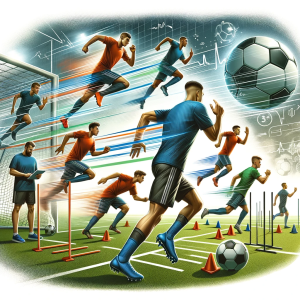
Referee Bias and Body Size in Soccer: Does Height Matter?
Imagine being a soccer player standing tall on the field, confident in your abilities. But what if your height alone could make you more likely to be penalized by the referee? Sounds strange, right? Well, research suggests that your physical stature might be influencing how referees call the game—and not always in your favor.
That’s right—the difference in height between players and referees could actually affect the number of fouls and yellow cards given out during a match.
In a study from professional German soccer leagues, researchers uncovered a surprising trend. Referees, even those who are highly trained and monitored, tend to show bias based on the physical size of players. The research highlights what’s known as the “Napoleon complex,” a term referring to shorter individuals compensating for their lack of height by displaying more aggressive behaviors. But in this case, it’s not the players but the referees who seem to adjust their decision-making based on height differences.
The Height Bias Uncovered
The study analyzed data from over 50,000 player-match observations, focusing on how often referees called fouls or issued yellow cards based on the height difference between themselves and the players. The findings revealed something fascinating: players taller than the referee were penalized more frequently. On the flip side, shorter players seemed to get away with more, receiving fewer fouls and cards.
Specifically, when players were taller than referees, they were up to 9.4% more likely to be penalized for fouls and 7.2% more likely to receive a yellow card. In contrast, shorter players saw a reduction in fouls by 12.3% and a drop in yellow card likelihood by 16.5%.
This creates a dynamic where referees, perhaps subconsciously, use sanctions like fouls and cards to assert authority when they feel physically inferior. In situations where the referee is shorter, they may feel the need to establish dominance over taller players. Conversely, when referees are taller than the players, they seem to feel more comfortable managing the game without the need for strict sanctions.
An Evolutionary Perspective
So why does this happen? The research draws on ideas from evolutionary psychology to explain this bias. Throughout history, height has been associated with social dominance. Taller individuals often hold more authority simply because of their size. In conflict situations, shorter individuals may feel the need to compensate by being more aggressive or authoritative. It’s likely that these psychological underpinnings are influencing how referees react on the field.
This bias isn’t just a small blip in the data. The study found that referees tended to impose stricter rules during the first half of the match, especially when they felt the need to “send a message” to taller players early on. In the second half, the bias softened slightly but still remained present.
Does Talent Play a Role?
Interestingly, the height bias wasn’t as strong when referees dealt with highly talented players or teams. Why? Because the costs of penalizing a well-known, highly valued player are much higher. Referees seemed to be more lenient with star players, understanding that harsh sanctions could lead to backlash or even impact their professional evaluations.
This reveals another layer to the issue: not only does height influence referee behavior, but so does the reputation and talent level of the players involved. Referees are making calculated decisions based not only on size but also on the potential consequences of their calls.
Experience Doesn’t Eliminate Bias
One might think that more experienced referees are better at avoiding this kind of bias, but the data tells a different story. While experience slightly reduced the height bias, it didn’t eliminate it. Even referees with years of professional experience showed a tendency to penalize taller players more harshly. This suggests that the bias may be deeply ingrained, even in the most seasoned officials.
Real-World Implications for Soccer Coaching
For coaches, players, and club managers, these findings have practical implications. If you have a particularly tall player on your team, it might be worth considering how they interact with the referees during a match. A heightened awareness of how height plays into decision-making could help teams anticipate potential biases and adjust their strategies accordingly.
For example, taller players might need to learn to avoid situations where referees could perceive them as overly aggressive. On the flip side, shorter players could benefit from an understanding that they may have more leeway in their actions on the field. Referees, too, can take note of these biases and work towards more fair and consistent decision-making, regardless of a player’s height.
Applications
1. Coaching Adjustments: Coaches can train their taller players to be extra cautious in their interactions with referees. Teaching them to avoid aggressive body language or physical challenges early in the game could help mitigate the chance of biased penalties.
2. Player Development: Understanding the height bias allows for targeted player development. Taller players may need to work on techniques that reduce the likelihood of being perceived as overly dominant or aggressive, while shorter players can leverage their perceived leniency to play more freely.
3. Club Management: From a club management perspective, height bias awareness can factor into team-building strategies. Ensuring a balanced roster, in terms of physical stature, might reduce the likelihood of referee bias affecting game outcomes.
By uncovering this subtle bias, the research opens up a new avenue for improving fairness in soccer officiating. While referees are tasked with making split-second decisions, understanding and addressing subconscious biases—like those based on height—could lead to a more balanced and impartial game. For players, coaches, and fans, it’s an eye-opener, revealing just how much more goes into the beautiful game than what meets the eye.
Elevate your understanding of the beautiful game with ‘This Week in Soccer’.
Subscribe now to our newsletter and be part of a community that transforms theoretical knowledge into practical mastery. Don’t miss out on the chance to access groundbreaking insights and redefine your approach to soccer. Subscribe today!



